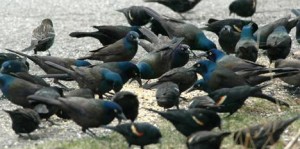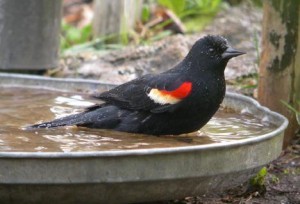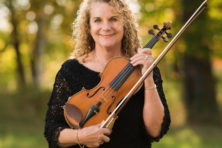Door to Nature
- Share
- Tweet
- Pin
- Share
Weather-wise, this has been what I consider to be a very favorable winter in many respects. A continuous deep layer of snow favors wild plants and provides extra soil moisture upon melting in spring; outdoor recreation, including cross-country skiing, snowshoeing and snowmobiling, has experienced one of the best winters in several years; snow shovel, snow blower, and sidewalk-salt sales have been up; and with the past few months having been excellent for birds, so too has the sale of bird food been good.
A winter like this is bound to produce some unusual sightings in nature. One occurring on Feb. 18, the morning after the heavy wet snowfall, involved four different observations reported to us by phone within a few hours, which ranged from Washington Island to Southern Door. The alert people saw many inch to inch-and-a-half-long caterpillars crawling on top of the snow. Brian Kroll, who lives along State Highway 57 between Baileys Harbor and Sister Bay, brought some to show us. We in turn photographed them and emailed images to our state entomologist in Madison, Phil Pellitteri.
His answer, minutes later, identified the creature as the Winter Cutworm, Noctua pronuba (nok-TO-a pro-NEW-ba). These larvae, which overwinter in the soil as generally fully-developed caterpillars, will pupate in warmer weather emerging as Large Yellow Underwing Moths, brownish moths with yellow hind wings. They’ve been in the state only since 1997 and are not considered to be harmful, other than possibly to lawns and vegetable transplants upon which the larvae are known to feed.
Now that the challenging winter is mostly behind us, we look forward to March with great enthusiasm in that soon the first small migratory songbirds will be arriving. My wife Charlotte, who is an excellent observer, monitor and meticulous record keeper, has kept track of northern Door County’s bird arrival and departure dates for the past 31 years. Five species head the top of her list, the Red-winged Blackbird (a few here all winter in 2002), Common Grackle (March 2), Song Sparrow (March 12), Brown-headed Cowbird (March 8), and Eastern Meadowlark (a few here all winter in 2008). Dates in parentheses are first arrival dates. Depending upon regional weather, the earliest arrival dates can usually vary from year to year by around two weeks or more. Sandhill Cranes, one of the largest birds to migrate to and nest in Door County, arrived on March 2 in 2004 and on March 23 in 2005. This is the range of dates when these beautiful birds can be expected.
I don’t know of a more easily identified and welcome wild bird song than that of the male Red-winged Blackbird’s “o-ka-LEE,” or “ong-ka-LEE,” or possibly “conk-kar-REE” as various people phonetically analyze the strong, far-reaching song. To me, these early birds might just as well be saying, “Spring is here!” Two male Redwings have taken up residence at our feeders over the past three or four summers and I must admit that their first songs are a joy to hear but that thrill diminishes fast as summer progresses. Those two birds became very bossy at the feeders and their high, piercing, ear-splitting whistles get on one’s nerves after a while.
Occasionally a bird sheds new light on how many years one can actually live. I was banding songbirds a number of years ago with a class of fifth graders at the Ridges Sanctuary. One of the birds we captured was a male Red-winged Blackbird. Much to my pleasure he was already banded. I recognized the first three digits (622) on his aluminum leg band as possibly being my band series from a previous year.
As soon as I recorded the entire number and released the bird I went into the house to check my past records. You can imagine our surprise and delight when I learned that I had banded that bird 10 years earlier when it already was an adult. In other words, that Redwing could have been a year or more older than 10 years. What tough, resourceful birds they are!
It should not come as a surprise to learn that the Red-winged Blackbirds have become the most numerous native songbirds in North America. Humans have provided them with everything they need to survive well. These champions of early spring will continue to be the flashy masters of the marshes and roadside ditches for years to come.
Name a handsome bird about a foot long which has glossy iridescent shades of bronze, violet, green, and purple on its head and upper body. Their wedge-shaped tails, formed into a neat keel during flight, are quite distinctive and help one to easily separate them from other blackbirds and European Starlings. If you were to add that this conspicuous creature displays a dignified swaggering walk, surely you would visualize this bold bird as the Common Grackle, our other rather abundant so-called blackbird. Like the American Robins, European Starlings, various waterfowl, and Red-winged Blackbirds, the Grackles migrate during daylight hours in the footsteps of spring. They remind me of adventurous (sometimes downright naughty) youngsters who enjoy mud puddles, small rivulets, and just getting close to the water or into the shallow parts without getting too wet. In this respect I also would have been a typical Grackle.
The pompous musical efforts of the males are amusing to some, annoying to others. Watch a flashy male in his breeding plumage puff up his chest as though he were being inflated in readiness for a grandiose vocal performance. Instead out struggles the squeakiest, raspiest, rustiest, “chacking” call you could imagine. Mr. A.A. Saunders, birdsong expert of years ago, described the Grackle’s song as saying “Kuchaku-WEE-ee-K-ee-KU-waa-a.”
One must separate biological facts from stormy emotions when deciding on this bird’s place in the “scheme of things.” The changes in our culture and lifestyles are providing Grackles with more food and nesting sites than ever before. Perhaps we should look at the problem as being entirely of our own making instead of placing these birds in the unwanted category. How glorious the day will be when all people become a part of Nature instead of masters over Nature, and can live with Common Grackles and Red-winged Blackbirds as easily as with Black-capped Chickadees!






